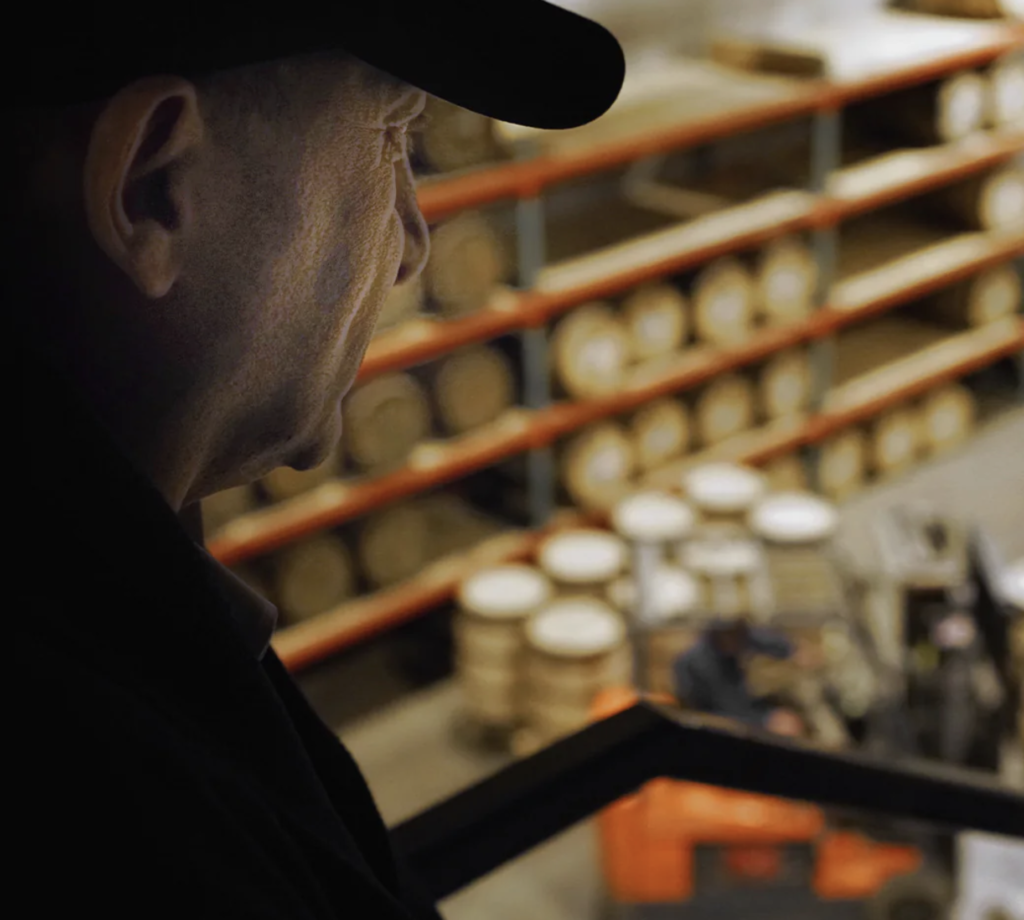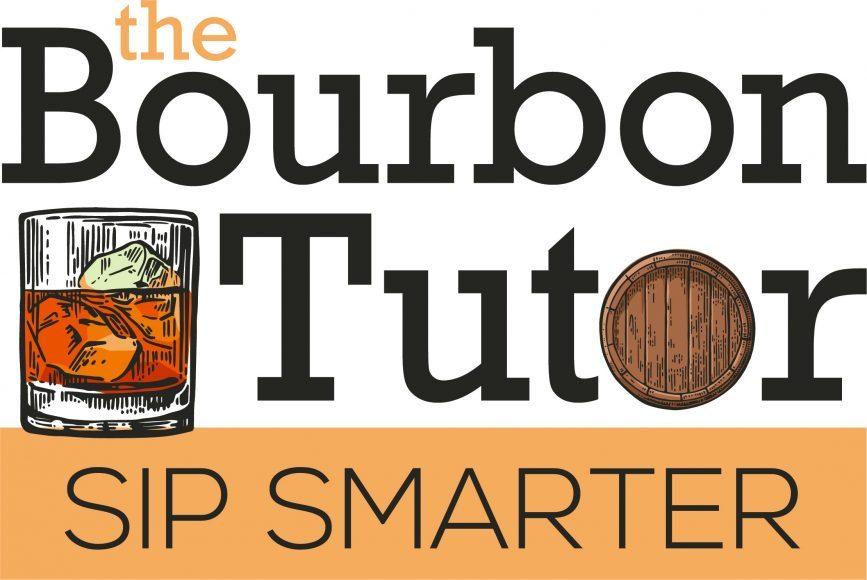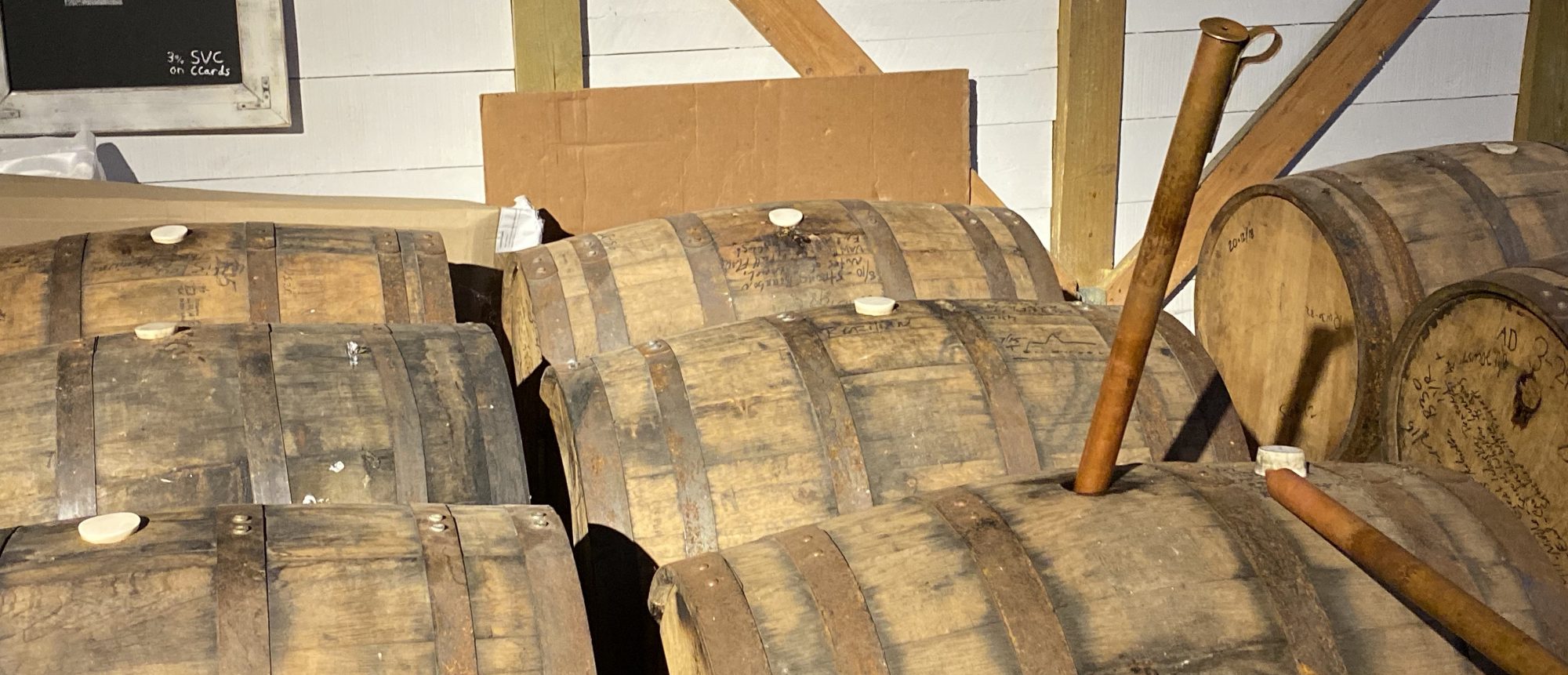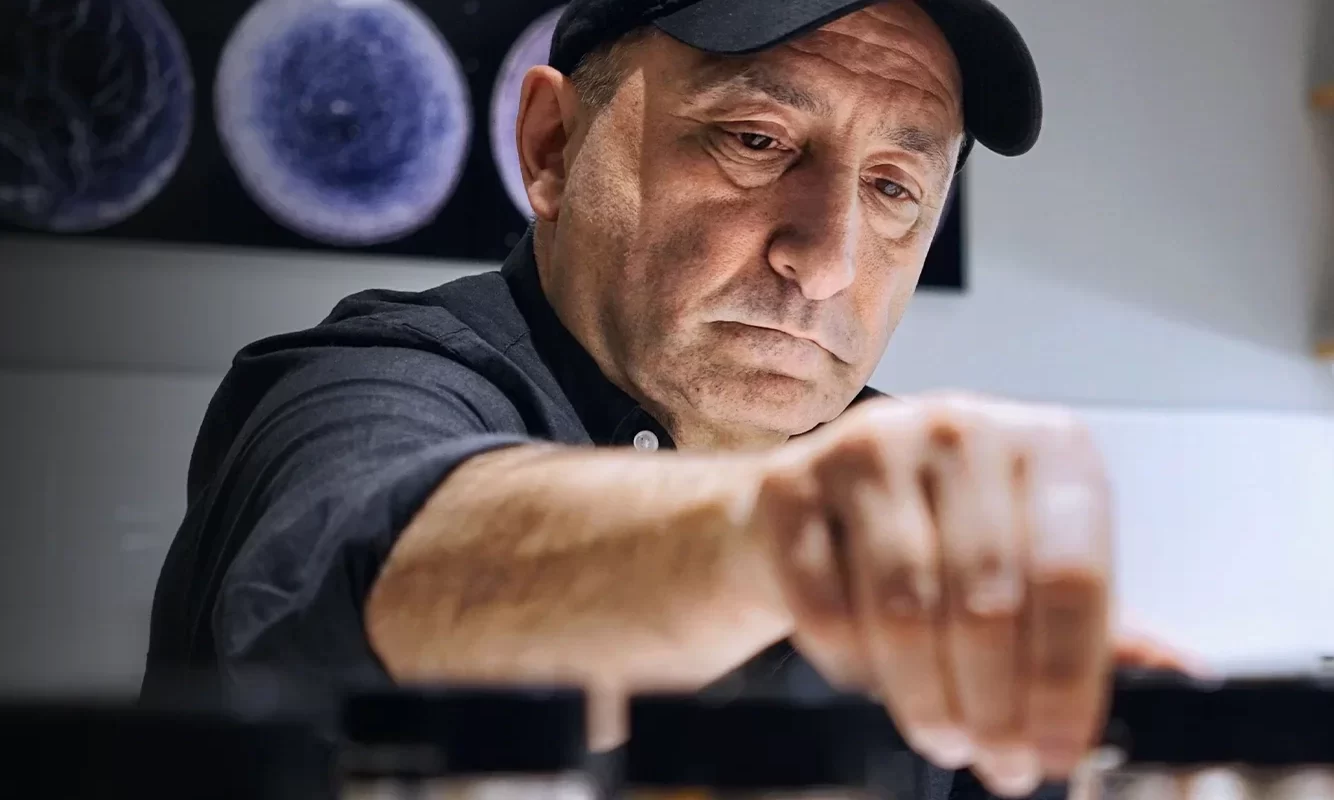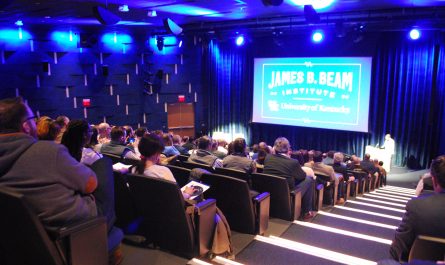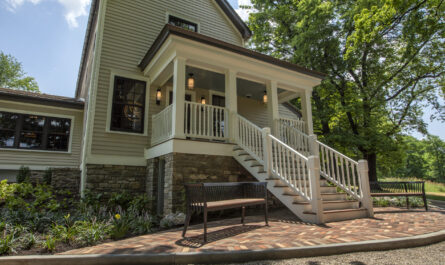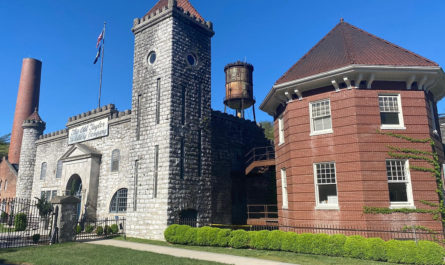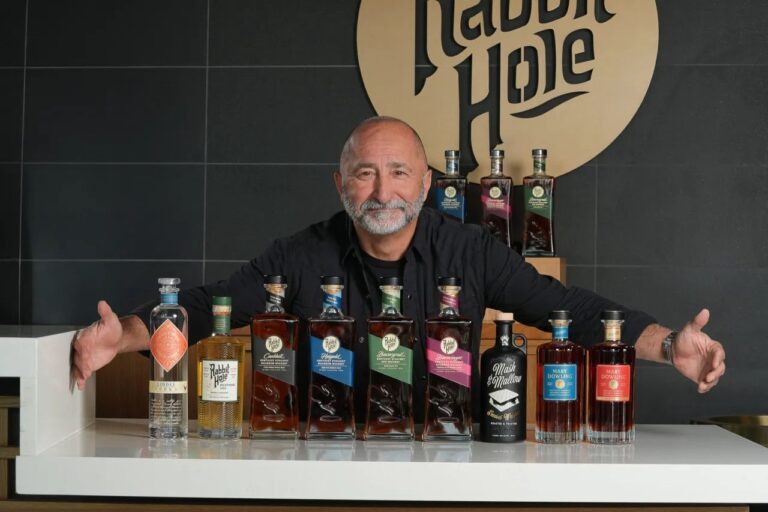
Kaveh Zamanian’s Bourbon Story Would Make a Great Movie
It sounds like a feel-good movie script, except most people wouldn’t believe it.
A young boy comes to America with his parents as an immigrant from Iran. As a man, he earns a Ph.D. and becomes a clinical psychologist in Chicago. After a successful 20-year career, he uproots his family to come to Louisville and start a bourbon distillery. It’s an industry he admits he knows little about. A dozen years later, his venture is described as “one of the fastest growing American Whiskey brands in the country.” Determined to do things his own way, this plucky newcomer is, nevertheless, welcomed by the whiskey industry. Financial success comes for the business and awards come to the former psychologist/psychoanalyst/academic. Accolades include his induction into the Kentucky Bourbon Hall of Fame after only a decade in the business.
Kaveh Zamanian is ready for his close-up.
Zamanian founded Rabbit Hole Spirits in 2012. Seven years later, Rabbit Hole partnered with Pernod Ricard, the second-largest spirit company in the world. Today, Zamanian is posed to make Louisville the hub of the American Whiskey world.
I recently sat down with Zamanian in his conference on the top floor of Rabbit Hole Distillery, overlooking its growing campus. Here’s an edited look at our conversation.

BGM: Your story is anything but typical in the whiskey industry. Tell me how you (a self-proclaimed “wine and spirits guy”) came to leave a clinical practice as a psychologist in Chicago to start your own whiskey distillery in Kentucky.
KZ: I cut my teeth in the hospitality business when I was a kid growing up. I put myself through college and graduate school, working different bars and restaurants. It left an impression on me. I really enjoyed the world of hospitality particularly fine wine and spirits. The idea of creating something that resonates with people was exciting. I think that food and spirits are a way to bring people together.
That was in the background when I met my wife Heather. She’s a fourth generation Kentuckian. We met in Chicago, now 21 years ago, and I started coming down to Louisville with her. Twenty-one years ago bourbon was not what it is today. For me bourbon was a revelation, I discovered old ‘dusties’ and learned more about the history of bourbon and Kentucky. I became really fascinated with the rich history and tradition of bourbon and the depth of American whiskey. My academic side was intrigued. The more I learned, the more fascinated I became. I thought there is an opportunity here to be able to get in the bourbon industry in a way that is meaningful. I was not interested in “rinse and repeat,” simply sourcing and blending, I wanted to create original expressions of bourbon and rye whiskey.
I summarize bourbon, from a making standpoint, as 51% corn and 49% possibility, or 49% opportunity. It’s the closest way of whiskey making where, similar to the culinary approach, like a chef, it starts with selection of grains and decisions that go into making, from cooking process, fermentation, etc. I felt like it’s an opportunity to be able to do something different than just going out there, buying aged products, and blending them. Nothing wrong with that; I think there’s a lot of folks that have done that well.
It felt like, if I really want to do something that stands out, I’ve got to do something that stands out and stands the test of time. So, this mash bill recipe approach was part of what intrigued me. It began my thinking that Rabbit Hole can come in and have something original to say in the American whiskey category.
BGM: You talk about bourbon being 49% possibility. Louisville promotes itself as “Possibility City.” Coincidence?
KZ: I think you’re spot on. One of the lovely things about Louisville and Kentucky is the fact that there is a lot of opportunity. Twenty-one years ago, I felt like Louisville and Kentucky were getting a bad rap nationally. Most people don’t know much about the region and have inaccurate perceptions about this part of the country. Louisville and Kentucky have a long, proud history, and rich culture and tradition as it pertains to whiskey and, most importantly, the friendliness of the people. Think about a guy named Kaveh coming to Louisville to start a bourbon company. In any place that is daunting, but in Kentucky, the prime time for bourbon? For me, Louisville ended up being the right place, hospitable, open to new ideas, with a friendly, gracious, and helpful industry.
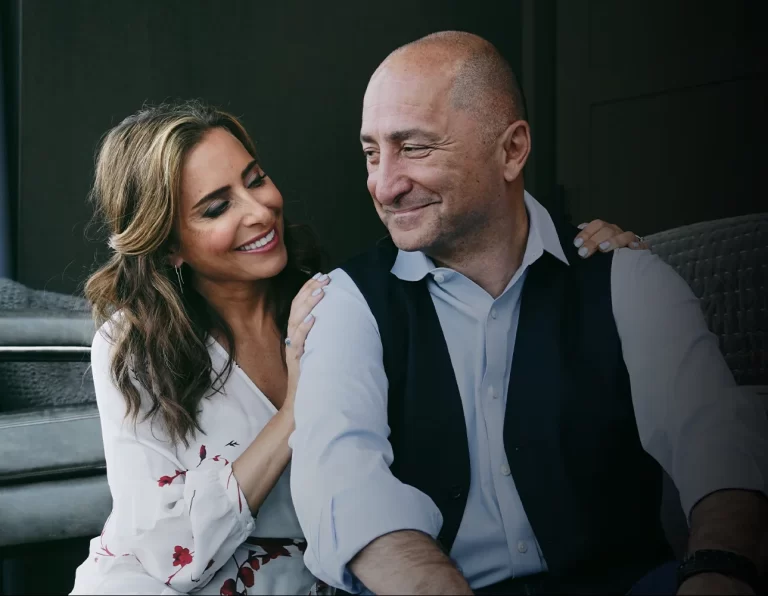
BGM: You made the decision to change careers, move to Kentucky, and open a distillery. Tell me how this unique name, Rabbit Hole, came about.
KZ: There are a couple of reasons. The first one, that’s a little bit more playful and whimsical, happened organically. My wife Heather and I, at the time , we had three little ones. Our son Henri was seven years old, daughter Jill was five, and Bella was four. Now they’re all grown up. But at the time, imagine with three little kids, basically telling my wife that I’m thinking about closing my practice, and getting into the bourbon industry (that I know very little about then). First she was stunned and thought I was kidding. Then she used to joke around that I was going to take the family down the rabbit hole. That basically became her mantra…she used to say it quite a bit. After half a dozen times it stuck. I called our attorney and found out the trademark for Rabbit Hole was available, and the rest is history. We decided that it’s a great name for our brand.
But, and this goes back to my psychology days, part of what is special about the name Rabbit Hole is the idea of transformation. Going down the Rabbit Hold signifies an opportunity for change, just like Alice at the beginning of Lewis Carroll’s story. I was bored with the bourbon offerings on the shelf, and instinctively I followed my white rabbit hole, the dream of becoming a whiskey maker, not knowing where I’m going to end up. If we really want to live a full life, and we’re passionate about something, sometimes we really need to take that leap. Not knowing exactly where we’re going to end up. But if you have a vision and believe in it, you’ve got to jump in. In some ways, Rabbit Hole became kind of a metaphor for transformation, for personal growth. I felt the brand perhaps could, through our products and story, be a source of inspiration for people to find their dream and go after it.
BGM: I’ve read this phrase on your website and social media: “No shortcuts. No compromise. Nothing left to chance.” Tell me about your business philosophy and why that approach is important to your success.
KZ: Ultimately the vision behind Rabbit Hole was to create a premium product for folks that want to be sipping, savoring, and enjoying, quality spirits neat, on the roacks or in a cocktai, a product that’s made with care and quality. That’s where this idea of no shortcuts and no compromises came to be. From grain to bottle and everything in between, including our distillery. The distillery was designed to embody our transparancy and craftsmanship. The idea of nothing left to chance is about attention to detail in every step of the process. That includes having a capable team. The challenging thing about our business is that it’s not just about making one or two good batches of whiskey. It’s about the talent and the ability to scale it with consistency and quality. That’s where you need a clear and dialed-in approach, a great team, and a great company culture.
BGM: When you search for Rabbit Hole Distillery, you see phrases like, “one-of-a-kind… unique…bold…unconventional.” Why do those attributes matter to you and why do you think they resonate with your customers?
KZ: There are a lot of great products out there. What I wanted to do is to create whiskey expressions that are one-of-a-kind. It was a very intentional decision not to go buy aged products, but to create my own recipes. I joke around that if, God forbid, our barrel warehouses went up in smoke, we couldn’t go out there and buy, and source, and blend these products. If you want something that’s genuinely unique, you’re able to get that. Our Cavehill Bourbon is an example: it’s a four-grain, triple malt bourbon. Cavehill is a one-of-kind recipe. There are other four grain bourbons out there. but not with this combination of grains and not with the same degree of attention to, not only the process but, the barrels and the caring that goes into the blending and maturation of it.
What is beautiful about American whiskey is that opportunity that you can do something creatively, starting with the grain bill. That’s the culinary parallel, like a chef in a kitchen. In our case, a culinary distillery kitchen.
Our core products Cavehill Bourbon and Heigold (high rye) Bourbon are two very distinct recipes of bourbon sitting side by side. Dareringer is a third recipe of bourbon, but we stretch our creative wings a little bit more. We finish that in Pedro Ximenez Sherry casks. There’s a whole other layer of intricacies that go into that.

BGM: You built the state-of-the-art Rabbit Hole distillery in downtown Louisville’s NuLu neighborhood that we’re sitting in right now. It’s safe to say it doesn’t look anything like a traditional distillery, or any of the other buildings downtown. Why was it important for your distillery to be so architecturally unique?
KZ: Part of it is about authenticity and being genuine. I wanted a distillery that not only is able to help us create exceptional products, but also represents what the brand is about. Rabbit Hole lives and breathes authenticity and transparency and the distillery reflects those values. Also, as a brand, we aim to bridge the gap between tradition and modernity. That’s what this facility represents. A modern building, state-of-the-art craft distillery, sitting in one of the oldest neighborhoods in Louisville. Rabbit Hole is a craft distillery that’s designed to scale. We genuinely make small batch expressions – we’ve got an 8000-gallon cooker and an 8000-gallon fermenter. Every batch we make is yielding about 20 to 23 barrels. But collectively, when you put the place together, we’re producing 26-to-27,000 barrels. It gives us the opportunity to scale the products that we like and then also be able to experiment on the small batch basis, creating different recipes and playing around.
I wanted all that to be set up where our visitors have a full sensory experience and enjoy seeing every step of the process. They’re literally raised above the manufacturing floor and able to see every part of the operation in full view. My vision was to educate, entertain, and elevate American whiskey. I want our visitors from around the world to discover bourbon, to get educated on what bourbon is, see the possibility of American whiskey, and to be entertained in the process. I felt like bourbon was in this state of malaise; not very vibrant, not very exciting. I wanted to bring color, vibrancy, and life to it through our distillery experience.
BGM: In December, you announced a considerable expansion of the distillery property. How is that progressing?
KZ: It’s in process and going well. We’re working with the city and the neighborhood, hoping to get ready for our expansion. We’re not increasing production capacity, but are expanding our hospitality footprint, adding tasting rooms, creating a single barrel experience, and adding office space for our team. We partnered with Pernod Ricard, about five years ago. Part of that partnership vision was the hope that, one day, our Louisville campus could serve as the hub for the company’s American whiskey brands (Rabbit Hole, Jefferson’s Bourbon, Smooth Ambler, TX Whiskey, and Skrewball).
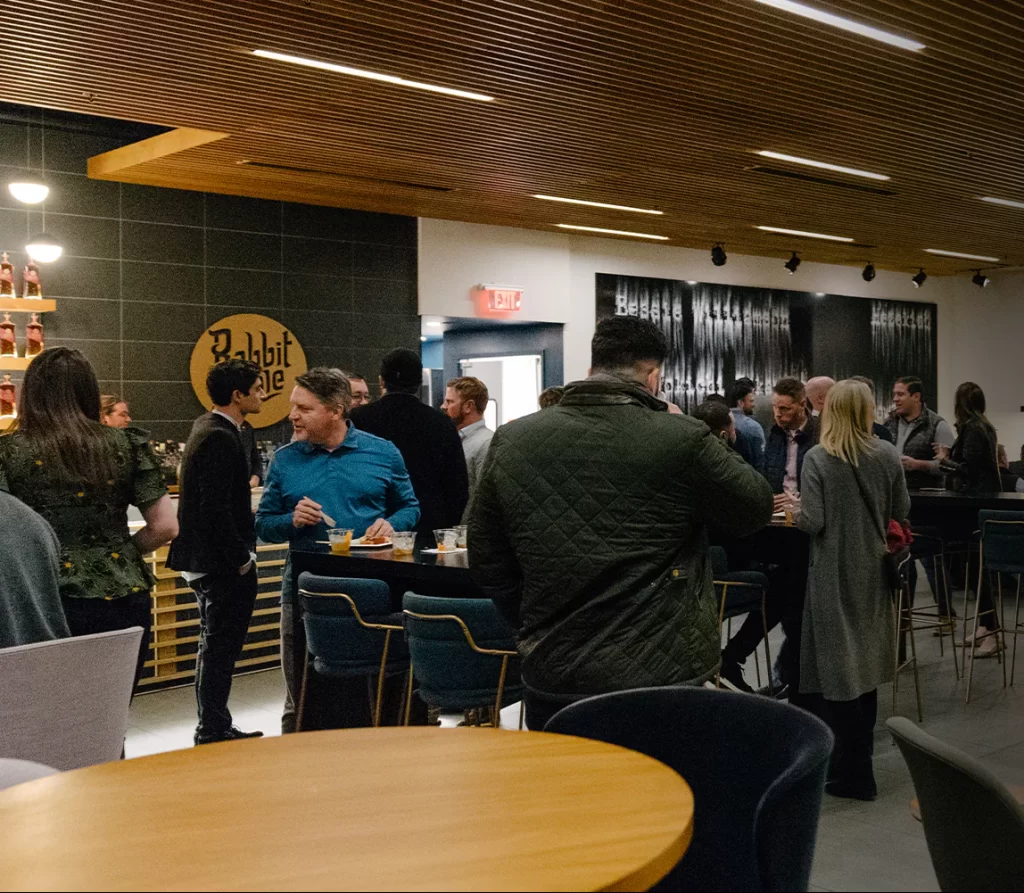
BGM: What can people expect when they visit Rabbit Hole Distillery, especially as it compares to some of the other stops along the Kentucky Bourbon Trail?
KZ: Our facility has been named the architectural icon of the Kentucky Bourbon Trail. It is an absolutely unique bourbon tour experience. As a visitor, you’re going to see every step of the process in full view. That’s a rare opportunity. There’s really no place like it in the US where manufacturing and hospitality are in one space. This was one of the most challenging things about the design and development of this project — we don’t have separation between operations and hospitality. You can sit at the top platform, view the top of the still, enjoy a bird’s eye view of the fermentation tanks, enjoy the process, but at the same time taste an exceptional ranged of bourbon and rye whiskeys, along with a few other fine spirits.
You’re going to be able to not only taste our core products, but there’s some lovely single barrels, and our distillery series releases which are our experiments with different wood finishes from French oak to Japanese oak to cognac casks.

BGM: I was at the ceremony almost two years where you were inducted into the Kentucky Bourbon Hall of Fame. What did that day mean to you, being surrounded by friends, family, and co-workers?
KZ: You know, honestly, it was one of the most memorable days of my life. Every time I think about it, I get goosebumps and have to pinch myself. Part of it is really a testament to the industry. The distilling and whiskey community in Kentucky is, by far, one of the most gracious groups that I’ve known. The folks, particularly the Kentucky Distillers’ Association, are just absolutely lovely. They welcomed me with open arms. Their measure is simple: they just want people who genuinely care about bourbon and Kentucky to shine a light on its storied past and glorious future. I’m honored to be welcomed into an esteemed group of professionals, who I admire and respect. Also to now be part of a long tradition and heritage of whiskey making in America. Imagine a guy from Iran, an immigrant, moved here as a kid, grew up in Southern California, come to Kentucky, of all places, with a name like Kaveh, and to be able to make it to the Kentucky Bourbon Hall of Fame… honestly there are days that I wake up and I can’t believe it. I think it’s a combination of good fortune, an incredible system of family and friends, and an amazing team, and plenty of sweat, hard work, and determination. It’s been an amazing ride; one of the highest achievements of my life.
BGM: How do you feel about achieving so much success in the whiskey industry in such a relatively short time?
KZ: I think it speaks more about the graciousness of my colleagues and the good folks in the industry. They have recongnized that one of the things that we’ve done with Rabbit Hole is raised the bar for the category. From our approach to making bourbon, to the design of the distillery, the shape of our bottles; it’s all part of a spirit of innovation and moving the category and the industry forward. I think part of what allowed me to get into the Kentucky Bourbon Hall of Fame is my colleagues’ ability to recognize that we have raised the standards, pushed the envelope, and created products and a brand that respect the long tradition of whiskey making in Kentucky, while standing out as genuinely distinct, not just going out there to do the same thing.
I believe that my success is also tied to our company culture and our inclusive and collaborative approach. We don’t have a master distiller. I share that because it exemplifies our approach. Making whiskey is a team effort. As long as you’ve got a tight group of talented folks who are able to work together, create a space where good ideas flourish, I think great things can happen. I think Rabbit Hole is almost like Willy Wonka’s Chocolate Factory. I want people to be happy to come to work. Team members come in, are able to contribute, and see their ideas come to life.
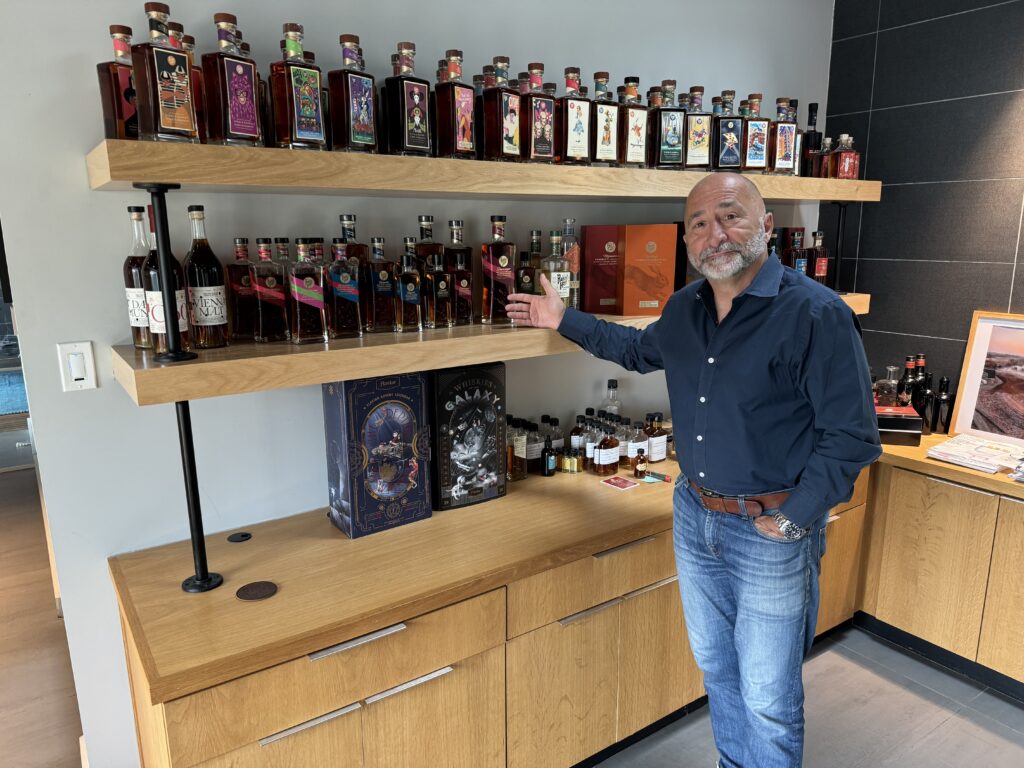
BGM: Let’s talk about your taste in whiskey. If we went downstairs to the tasting room and bar, what would you reach for first and why?
KZ: It really is constantly evolving. (Walks to a bar in the conference room that displays all the Rabbit Hole products) I’ve got the core products lined up here. Cavehill and Heigold, we’ve talked about. These are kind of the 1-2 for me on regular basis. Dareringer, interestingly enough, is our fastest growing expression. It’s sweeter. It’s a good after-dinner drink or also great in a Manhattan, a pretty easy drinker.
Then the same thing with the ryes. These are my go-to choices when I’m out and about. When I’m here at the distillery or when I’m places that have it, our single barrels are just really lovely. They’re an elevated version of our core expressions. They’re offered at cask strength, so you get more of a full-flavored, full-bodied expression.
Then our Distillery Series expressions are unique. This one right here is our rye finished in cognac, it’s fantastic. One of the biggest fan favorites is the rye that was finished in vermouth.
The Founder’s Collection comes out twice a year. This is a whole other level for folks that are serious about their whiskey. We put higher-aged products in here, or what I call “funky recipes.” Like this one, Raceking, this is a five-grain double-chocolate malt bourbon. This is a French oak finish, this is a Japanese oak finish. This is Dareringer in the Founder’s Collection. But the difference for Founder’s is that we aged it in barrels made in Spain that had Pedro Ximenez Sherry in their bellies for 30 to 40 years. The barrels are so rich.
You need a great team to be able to make sure that those products are produced consistently. The quality checks on these are really important. I want to make sure that if you pick a bottle of Rabbit Hole, every time you pull it, you’re getting the same thing that you want, that you expect, with that same quality standard.
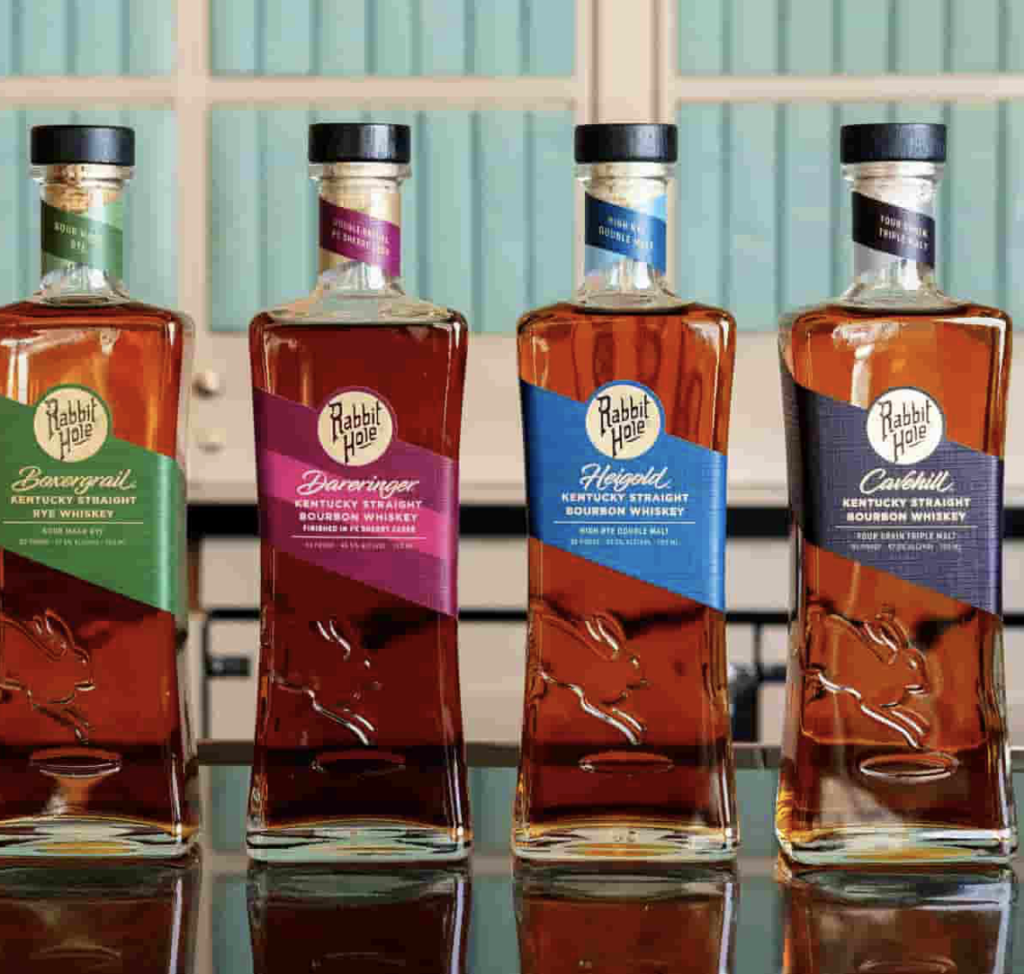
BGM: Where do you see the bourbon industry going in the next decade or two? Can the current bourbon boom continue to grow?
KZ: I don’t think we’re going to see growth at the same rate that we have in the last 10 years. I think we’re going to see more modest growth. I think we’re going to see a little bit of a contraction in terms of the number of producers. Simply because there are a lot of products out there, there are a lot of brands. There are also distribution and route-to-market challenges, along with the fact that consumers are still learning about bourbon and American whiskey. In all, there’s been massive growth in the last ten years, accelerated through COVID years, and now a return to normal growth rates. So, in my opinion, there are going to be winners and losers in the next three-to-five years. Very similar to what happened with the craft beer industry. I think that’s the way the bourbon industry is going to go as well. You’re going to have folks who are going to have partnerships, where they can go to national, maybe even international levels. But it’s just very expensive to establish a national and international brand, so many will remain regional.
BGM: What does the future hold for Kaveh Zamanian and Rabbit Hole Distillery?
KZ: Brian, you might actually be the first person hearing this in a formal way. As part of our campus expansion, Louisville is going to be established as the hub for American whiskey for Pernod Ricard. Very similar to the way they have Irish distillers out of Cork and Middleton, Chivas Brothers out of Scotland, or Absolute out of Sweden. North American Distillers is going to be situated here in Louisville, Kentucky on this campus. I’m actually stepping down as the CEO of Rabbit Hole and stepping into the role of Chief Whiskey Officer for the North American Distillers (Pernod Ricard) organization. My role is going to expand in some ways to oversee the portfolio, specifically liquid creation and innovation, for Rabbit Hole, Jefferson, TX, and Smooth Amber. Along with my team, I will guide the direction of these product in the brands. It’s not every day that you can help build a new organization for the ground up. I’m very excited about the prospects of this group.
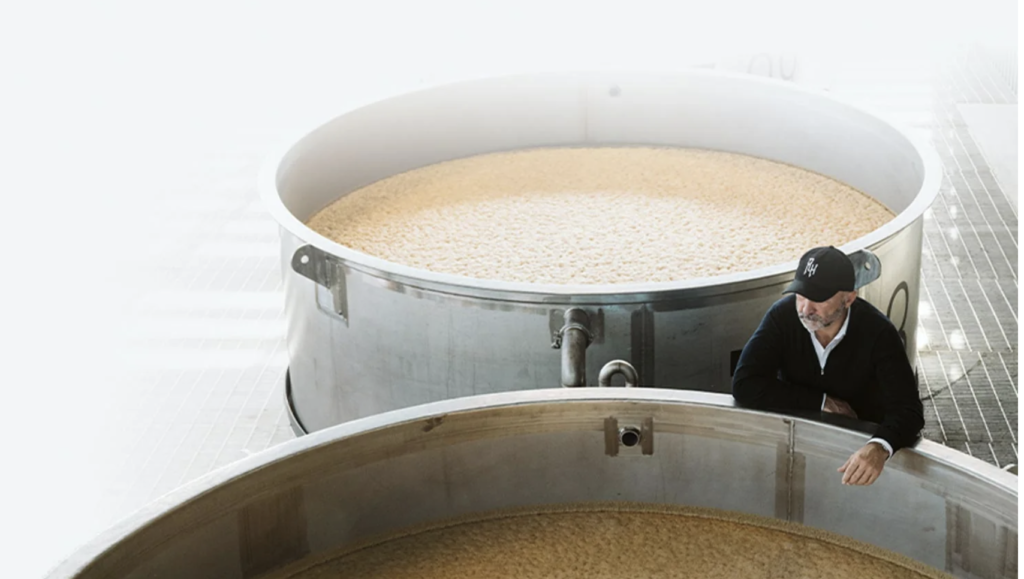
BGM: Last question: what do Heather and your kids think now that you’ve come through the rabbit hole? What has the ride been like for the family?
KZ: As I said, we have a son and two daughters. What’s funny is, my son Henri, is the only one that remembers me as a psychologist. The other two, Lili and Bella, don’t even remember me as a psychologist. Their memory and recollection is just Rabbit Hole. We have pictures of us right here where this place was an abandoned tire factory and when we were building it. They’ve been a part of it from the beginning. I think there’s a lot of excitement and enthusiasm. Sometimes the kids joke around with me now, that with Instagram and social media, I’m getting too big for my britches. But it’s been a fun ride. Heather is absolutely enjoying it. Now we’re at the point where the kids are older…Heather’s joining me more now when we’re out and about, which is lovely. Now with Mary Dowling (Whiskey Co.) Heather is considering helping and becoming more involved with the brand, perhaps as a spokesperson. It’s an amazing story of a maverick, the greatest American whiskey story that few know about. I think it’s best told by women who appreciate and understand the challenges of building a brand and running a business, while caring for a family. It’s a new chapter in our life, and we’re really excited about it
BGM: The city of Louisville is so happy to have you. You’ve become such a great corporate citizen with your company’s involvement. The city knows you’re here…as a person and as a family. It’s been a great thing to watch.
KZ: That means a lot to me. Thank you for sharing that. It makes me a little emotional!
